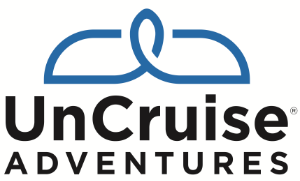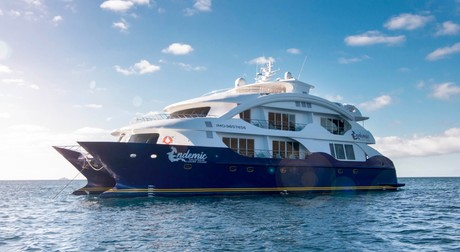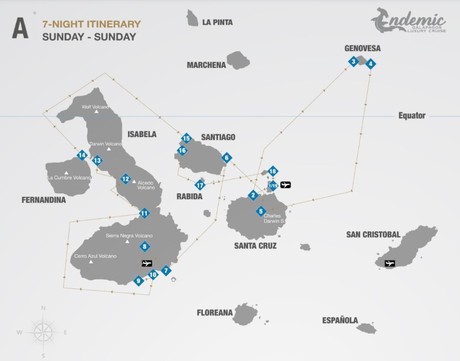Endemic 7-Night Cruise in Western Galapagos
Relax in luxury while sailing through the Galapagos Islands. The Endemic seven-night cruise, centered around Western Galapagos, includes visits to spectacular sites on Santa Cruz, Rabida, Santiago, Isabela, and Fernandina. We also include a short trip over to Genovesa Island located in the Northeastern Galapagos—a wonderful stop for bird lovers. The Endemic seven-night cruise in Western Galapagos extends Sunday to Sunday, giving you plenty of time to relax by yourself, with family, or with friends. Our exclusive Endemic yacht holds a maximum of sixteen passengers and has a limited eleven-person crew. This intimate size of our luxurious Galapagos cruise ship allows you to customize your weeklong cruise in the Western Galapagos to your needs.
For shorter, 3 or 4-night cruises, please contact us for more information.
Highlights
• Snorkeling with Marine Life: From snorkeling amid the vibrant marine ecosystems at Sullivan Bay to the chance encounters with sea turtles and Hammerhead sharks around Genovesa Island, you’ll experience some of the most thrilling underwater adventures the Galapagos has to offer.
• Unique Wildlife Encounters: Observe a range of endemic species in their natural habitats, such as the giant tortoises in the highlands of Santa Cruz Island, the nesting colonies of Flightless Cormorants at Punta Espinoza, and the elusive Short-eared Owl at Prince Philip’s Steps.
• Volcanic Landscapes and Historical Sites: Explore the dramatic volcanic landscapes of Sierra Negra Volcano and the human history at The Wall of Tears, offering a perfect blend of natural beauty and poignant historical narratives.
Sunday: AM: Arrival to Baltra Island Airport, reception and transfer to the yacht for the first visit.
Sunday: PM visit: Playa las Bachas/Bachas Beach, Santa Cruz Island.
The name “bachas” is derived from the English word ‘barges’ and dates from World War Two, when the USA had a military base in the Galapagos Islands. Bachas is a lovely beach, great for swimming or some easy snorkeling off shore. Shore birds like whimbrels and stilts are common, as are sea lions and Sally Lightfoot crabs. A brackish lagoon popular with flamingos is a short walk from the main beach.
Monday: AM visit: Bahía Darwin/Darwin Bay, Genovesa (Tower) Island.
The long-eroded remnants of a prehistoric volcanic crater, Genovesa Island has a distinctive crescent shape. A memorable visitor site on the bay leads through some mangroves and past many nesting birds including Red-footed and Nazca Boobys, Frigate Birds, gulls and more. From February to June, the Frigate Birds inflate their bright red throat pouches. Look for stingrays trapped in tidal pools at low tide. Following the visit, our guests will have the opportunity to snorkel, kayak or take a panga ride around the tranquil bay. Snorkelers sometimes see Hammerhead sharks!
Monday: PM Visit: El Barranco/Prince Philip’s Steps, Genovesa (Tower) Island.
Across Darwin Bay from the morning visitor site, Prince Philip’s Steps is a spectacular site for bird lovers. After a brief clamber up a rocky bluff, visitors emerge onto a plateau where they can see the elusive Short-eared Owl: this site is one of the only places in Galapagos where these birds are commonly seen. Look for Red-footed and Nazca Boobys, storm petrels and Tropic Birds. The visit is followed by the chance to do some more snorkeling or kayaking in the bay.
Tuesday: AM Visit: Los Gemelos/The Twins, Santa Cruz Island.
The “twins” of the leafy highlands of Santa Cruz island are two sinkholes created long ago by underground lava tunnels which collapsed. A shady trail covers the short distance between the main road and the two sinkholes. Your guides will explain about the special forest found in and around the sinkholes: it is home to many Scalesia pedunculate trees, endemic to Galapagos. The Twins visitor site is a good place to see finches, Vermilion Flycatchers and mockingbirds.
Continuing on, we will stay in the highlands of Santa Cruz Island to visit a ranch where giant tortoises can be seen in the wild. The islands were named after this giant creature that lives in the archipelago. During our visit you will easily spot these giants walking, eating and enjoying their natural habitat, they are totally friendly. In this area you can also see birds such as short-eared owls, Darwin finches, yellow warblers and paint-billed crackers. To finish our tour, you will walk through underground solidified lava tubes. Then the Endemic is waiting for you to move on with our journey in Galapagos.
Tuesday: PM Visit: Bahía Sullivan/Sullivan Bay, Santiago Island.
Sullivan Bay features a sandy shore surrounded by lava fields. The lava is relatively recent, being only about 100 years old. Guides will point out the hardy “pioneer” plants: specialized flora which is the first to colonize a lava field. After a hike, guests will enjoy a refreshing swim with the chance to do some snorkeling!
Wednesday: AM Visit: Humedales/Wetlands, Isabela Island.
Isabela Island’s wetlands are home to abundant bird life, including flamingos, stilts, whimbrels, gallinules, finches, Pintail Ducks, Brown Pelicans and more. Marine iguanas creep through the marshes as well, and an occasional giant tortoise makes an appearance. Part of the trail goes up Orchilla hill, which offers a nice view of the nearby town of Puerto Villamil.
Wednesday: AM Visit: Sierra Negra, Isabela Island.
Sierra Negra (“Black Mountain”) Volcano was active as recently as 2005 and it is possible to see very recent lava flows and fumaroles. The visit includes the main volcanic caldera and several smaller craters at the Chico Volcano site. There are not many animals in the barren heights of the volcano, but hikers are rewarded with an unforgettable lesson in volcanic geology and a great view of Isabela and Fernandina Islands!
Wednesday: PM visit: Centro de Crianza Arnaldo Tupiza /Arnaldo Tupiza Breeding Center, Isabela Island.
The Arnaldo Tupiza Breeding center is a highlight of any visit to Isabela Island. Here, giant tortoises of the Isabela Island subspecies are hatched and cared for until they can survive on their own in the wild. Hundreds of adorable baby tortoises lumber about in raised pens, designed to protect them from predators including rats and ants. Even the walk to get to the breeding center from town is fun, as it is connected to Puerto Villamil by a boardwalk over some marshy wetlands where sightings of flamingos and other water birds are common.
Wednesday: PM Visit: Muro de las lágrimas/The Wall of Tears, Isabela Island.
The Wall of Tears is a wide, high stone wall built not far from Puerto Villamil. A visit to the Wall of Tears offers a rare glimpse into the human history of the Galapagos; Isabela Island was once home to an Ecuadorian penal colony, and construction of the Wall of Tears was a form of punishment. Some locals think it’s haunted!
Thursday: AM Visit: Bahía Elizabeth/Elizabeth Bay, Isabela Island.
Elizabeth Bay and the small, rocky islets which are found there are home to many spectacular species of Galapagos bird life, including penguins, the Galapagos Hawk, Nazca Boobys, finches, flightless cormorants, warblers and more. In the clear sea below, visitors will see thriving marine life, including schools of fish, Spotted Eagle Rays, sea lions and marine iguanas. Elizabeth Bay is only seen by panga ride: visitors will not land at all.
Thursday: PM Visit: Bahía Urbina/Urbina Bay, Isabela Island.
In 1954, volcanic activity deep underground rocked Isabela Island, thrusting up part of Urbina Bay. The bay’s landscape changed overnight, gaining five meters in height and a kilometer of soggy land that had previously been underwater. Visitors can still see desiccated coral formations on the trail around part of the bay. Urbina Bay is home to abundant wildlife, including land iguanas, giant tortoises and lava lizards. Bird life includes finches, hawks and mockingbirds. The hike, a relatively long one at 3000 meters, is followed by a refreshing swim or some snorkeling in the bay.
Friday: AM visit: Caleta Tagus/Tagus Cove, Isabela Island.
A visit to Tagus cove includes a short hike to a scenic outlook and a panga ride along the coastline to look for penguins. After the hike, guests may choose to do some kayaking and snorkeling, where they are almost certain to see sea turtles.
Friday: PM visit: Punta Espinoza/Espinoza Point, Fernandina Island.
Punta Espinoza is one of the most remarkable visitor sites in all of Galapagos. This memorable hike includes good wildlife watching as well as geology and many spectacular spots for taking photos. Guests will walk over recent (geologically speaking) lava flows, see a nesting colony of Flightless Cormorants, and step gingerly through a low maze of marine iguanas sunning themselves. Look for lava lizards, Galapagos snakes and Galapagos Hawks.
Saturday: AM Visit: Caleta Bucanero/Buccaneer Cove, Santiago (James) Island.
The islands are so beautiful that it’s possible to forget about their interesting human history. Although there is nothing left of their presence (no buried treasure – sorry!), pirates and whalers used to stop in Buccaneer Cove to repair their ships, take on fresh water and capture tortoises for food. There is no trail here, but it is a good spot for a panga ride, snorkeling, and kayaking. As the panga cruises along the shore, look for Blue-footed and Nazca Boobys, fur seals, sea lions, and Galapagos Hawks soaring overhead.
Saturday: AM Visit: Playa Espumilla/Espumilla Beach, Santiago (James) Island.
Playa Espumilla (“Foamy Beach”) is a pristine sandy beach on the northern part of Santiago Island. At either end of the beach, trails lead through some mangroves to a salty lagoon, where lucky visitors may get to see flamingoes, Pintail Ducks, stilts or other wading birds. There is good snorkeling and kayaking off the beach.
Saturday: PM Visit: Rabida Island.
Rabida is a remarkable island, famous for its cactus groves and scenic rock formations. Finches and other small land birds are commonly seen flitting around the cacti alongside the trails. The hike starts along a red sand beach where Brown Pelicans nest in mangroves. Short trails lead from the beach to some lagoons where flamingos are sometimes seen. After the hike, visitors can cool off with a swim or some snorkeling. Lucky snorkelers and kayakers will see fish, sea lions and turtles.
Sunday: AM Visit: Mosquera Islet.
Mosquera is a sandy, sparsely vegetated sand bar known for sea lions, lava gulls, shorebirds and Sally Lightfoot crabs. Lucky visitors might get to see a Yellow-crowned Heron as well! The visit features a guided walk around the islet and the chance to snorkel offshore.
Transfer from the M/C Endemic to Baltra airport for your return flight to mainland Ecuador. Assistance and farewell at the airport.
Itineraries are subject to change.
|
Book now |
Cabin

|
Book now |
Cabin

|
Book now |
Cabin

|
Book now |
Cabin

Vessel Type: Luxury Catamaran
Length: 35 m
Passenger Capacity: 16
Built: 2018
Imagine a magical world of soaring frigate birds, lumbering tortoises, frolicking sea lions, and sleek sharks. Imagine cruising through cerulean waters on a luxurious, intimate yacht with your significant other, family, or friends. Picture a deluxe cabin, spacious and inviting as warm sea breezes blow in gently from the balcony. The staff is courteous and professional, the naturalist guide is knowledgeable and friendly, and the chef somehow sends one masterpiece after another out of the kitchen. This is your dream. This is the Endemic luxury cruise in the Galapagos.
The Endemic is not only one of the newest next-generation catamarans in the Enchanted Islands, but also the most luxurious. The outer design is sleek, streamlined, and attractive: the gentle curves of the hull and decks make the Endemic look like part of the unique Galapagos ecosystem.
Suites on a luxury catamaran like the Galapagos Endemic are typically much larger than cabins on older single-hulled yachts. Professional designers with shipboard experience designed ours for maximum comfort and elegance.
Each cabin has personalized air conditioning controls, a balcony, spacious private bathroom, and either a king-size bed or two twin-size beds. Naturally, each suite also boasts significant closet/drawer space and a writing desk and strongbox.
There’s no question that the engineers and designers who built our luxury catamaran for the Galapagos archipelago left nothing to chance. It is our privilege to provide our guests with the style and comfort of the Endemic, the finest vessel sailing in the Galapagos Islands! Book our luxury Galapagos Endemic cruise for your next vacation today.









Inclusions
• Transfers airport-yacht-airport in Galapagos
• Airport reception and assistance
• Double accommodation
• Guided expeditions according to the itinerary
• Top Bilingual National Park Guide (English/Spanish)
• Activity daily briefing
• Cruise Service Officer
• All meals & snacks
• Soft drinks and juices
• Captain’s welcome and farewell cocktail
• Use of yoga mats, kettlebells and dumbbells; stargazing laser pointer
• Expedition gear: sea kayaks, stand-up paddle boards, snorkeling equipment (mask, snorkel, wet suit, fins), water container, binoculars, action camera.
Exclusions
• Round trip flights to Galapagos
• Galapagos National Park Entrance Fee ($200 – subject to change)
• Transit Control Card ($20 – subject to change)
• Alcoholic beverages
• Gratuities for guide and crew
• Travel and Health insurance
• Micro SD card 4K (surcharge)
Our Associates Include







